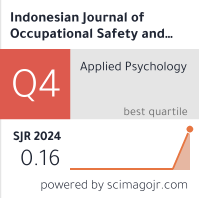The Risk Assessment on Bamboo Weaving Craftsmen in Rajapolah District Tasikmalaya Regency
Downloads
Introduction: Tasikmalaya Regency is one of the areas in West Java that has a large industrial potential, especially small and handicraft industries. Every workplace, both formal and informal, has various potential hazards that can affect the health of workers or can cause occupational diseases. As bamboo is sharp, the craftsmen must be very careful in treating bamboo as a woven materialbecause the risk of accidents such as cutting off hands, being punctured by bamboo slats, and the risk of other potential mechanical hazards can occur. The purpose of this study is to analyze the occupational health and safety risks of woven craftsmen in the Rajapolah District, Tasikmalaya Regency. Methods: This study was a descriptive study. 5 Bamboo weaving craftsmen were the subjects of this study. Meanwhile, the objects of this study were the work process and workplace environment. Data collection was carried out by observation and interviews. Data analysis was performed using a semi-quantitative risk analysis method according to AS/NZS 4360: 2004 standard. Results: 23 potential hazards are identified from all stages of the bamboo process, and 23 health and safety risks are identified from all potential hazards, with 1 risk at a lowrisk level, 15 risks at a medium risk level, and7 risks at a highrisk level. Conclusion: There are 7 risks at the high-risk level that must be prioritized for control, originating from the potential hazards of ergonomics and chemicals.
Aini, A. N. (2016) ‘Analisis Risiko Kerja Dan Upaya Pengendalian Bahaya Pada Petugas Pemadam Kebakaran Di Dinas Pemadam Kebakaran Kota Semarang', Jurnal Kesehatan Masyarakat, 4(1), pp. 277–283.
Ardam, K. A. Y. (2015) ‘Hubungan paparan debu dan lama paparan dengan gangguan faal paru pekerja overhaul power plant', The Indonesian Journal Of Occupational Safety and Health, 4(2), pp. 155–166.
Asriyati (2019) ‘Faktor-Faktor Yang Mempengaruhi Pembuatan Anyaman Bambu (Lambar) Di Desa Tanjungsari Kecamatan Petanahan Kabupaten Kebumen', Jurnal Riset Agribisnis dan Peternakan, 4(1), pp. 1–8.
Australian Standard/New Zealand Standards (2004) Handbook: Risk Management Guidelines Companion to AS/NZS 4360: 2004. Australia: Standards Australia/Standards New Zealand Australia.
Badan Penyelenggara Jaminan Sosial Ketenagakerjaan (2019) Kecelakaan Kerja Cenderung Meningkat, Kesehatan Kerja Badan Penyelenggara Jaminan Sosial membayar santunan Rp 1,2 Triliun. Jakarta: Badan Penyelenggara Jaminan Sosial Ketenagakerjaan.
Central Bureau of Statistics of Tasikmalaya Regency (2019) Kabupaten Rajapolah Dalam Angka 2019. Tasikmalaya: Central Bureau of Statistics of Tasikmalaya Regency.
Fani, H. (2013) ‘Safety Risk Assessment of Mechanical Hazards on Wood Furniture Workers In Informal Industry" Indah Jati Furniture"', in International Meeting of Public Health (IMOPH). Depok, pp. 1–14.
International Labor Organization (2013) Keselamatan dan Kesehatan Kerja Sarana untuk Produktivitas. Jakarta: International Labor Organization.
Jalajuwita, R. N. and Paskarini, I. (2015) ‘Hubungan posisi kerja dengan keluhan muskuloskeletal pada unit pengelasan PT. X Bekasi', The Indonesian Journal Of Occupational Safety and Health, 4(1), pp. 33–42.
Kamila, E. Z. (2018) Gambaran Kebisingan dan Potensi Bahayanya Serta Upaya Pengendalian pada Unit Pengolahan Teh di PT Candi Loka Kabupaten Ngawi Tahun 2018. Undergraduate Thesisi. Surabaya :Department of Environmental Health, Poltekes Surabaya.
Karuniawati, E. Y. (2018) ‘Analisis Kejadian Kebakaran dengan Metode "Loss Causation Pacitan', Jurnal Kesehatan Masyarakat, 6(4), pp. 286–291.
Ma'rufi, I. (2017) ‘Efek Pajanan Debu Kayu terhadap Gangguan Faal Paru', MPI (Media Pharmaceutica Indonesiana), 1(1), pp. 45–52.
Maharani, F. T. (2020) ‘Pengendalian Debu Kayu di PT.X', Indonesian Jurnal of Health Development, 2(1), pp. 1–14.
Mayasari, D. (2017) ‘Pencegahan Noise Induced Hearing Loss pada Pekerja Akibat Kebisingan', Jurnal Agromedicine, 4(2), pp. 354-360.
Mindayani, S. (2018) ‘Perbaikan Fasilitas Kerja Untuk Mengurangi Keluhan Muskuloskeletal', Jurnal Endurance, 3(2), pp. 313–324.
Ministry of Manpower of Republic of Indonesia (2018) Nomor 05 Tahun 2018 tentang Keselamatan dan Kesehatan Kerja di Lingkungan Kerja. Jakarta: Ministry of Manpower of Republic of Indonesia.
Muhammad, K. (2015) Pertolongan Pertama. Jakarta: PT Gramedia.
Mukhlish, W. I. N. (2018) ‘Pengaruh Kebisingan Terhadap Tekanan Darah dan Nadi pada Pekerja Pabrik Kayu PT. Muroco Jember', Jurnal Kesehatan Lingkungan Indonesia, 17(2), pp. 112–118.
Murti, K. A. H. (2018) ‘Kerajinan Anyam Bambu di Sanggar Hamid Jaya Desa Gintangan Kecamatan Rogojampi Kabupaten Banyuwangi', Jurnal Seni Rupa, 6(1), pp. 634–644.
Mustofani (2019) ‘Hubungan Antara Iklim Kerja dan Beban Kerja dengan Kelelahan Kerja pada Pekerja di Gudang 5 Area Fabrikasi PT. Bangun Sarana Baja', The Indonesian Journal Of Occupational Safety and Health, 8(2), pp. 150–157.
Prabawati, M. N. (2016) ‘Etnomatematika masyarakat pengrajin anyaman rajapolah kabupaten tasikmalaya', Infinity Journal, 5(1), pp. 25–31.
President of Republic of Indonesia (2009) Undang-Undang Nomor 36 Tahun 2009 Tentang Kesehatan. Jakarta: President of Republic of Indonesia.
Putri, R. N. (2019) ‘Permodelan Risiko Bahaya Kimia Guna Menentukan Pengendalian Bahaya Kesehatan', Journal of Industrial Hygiene and Occupational Health, 4(1), pp. 80–97.
Ramdan, I. M. (2013) Higiene Industri. Yogyakarta: Bimotry.
Ramli, S. (2010a) Manajemen Kebakaran. 1st edn. Jakarta: PT Dian Rakyat.
Ramli, S. (2010b) Sistem Manajemen Kesehatan dan Keselamatan Kerja OHSAS 18001. Jakarta: Dian Rakyat.
Rosanti, E. and Wulandari, D. (2016) ‘Pengaruh Perbaikan Kursi Kerja Terhadap Keluhan Muskuloskeletal pada Pekerjaan Menjahit di Desa X', Journal of Industrial Hygiene and Occupational Health, 1(1), pp. 23–38.
Santosa, Z. (2019) Mengatasi Luka Gores dan Luka Bakar. Yogyakarta: CV Alaf Media.
Sentra Informasi Keracunan Nasional (2011) 1-Napthol. Jakarta: National Agency of Drug and Food Control.
Setiadi, A. (2009) Sifat Kimia Beberapa Jenis Bambu pada Empat Tipe Ikatan Pembuluh. Thesis. Bogor: Faculty of Forestry, Institut Pertanian Bogor.
Shobib, M. N. (2013) Hubungan Antara Pengetahuan dan Sikap dengan Praktik Penggunaan APD pada Petani Pengguna Pestisida di Desa Curut Kecamatan Penawangan Kab. Grobogan Tahun 2013. Undergraduate Thesis. Semarang: Faculty of Health Science, Universitas Dian Nuswantoro.
Stamatis, D. (2014) ‘Preliminary Hazard Analysis (PHA)', in Introduction to Risk and Failures. Boca Raton: CRC Press.
Suma'mur, P. K. (2009) Higiene Perusahaan dan Kesehatan Kerja (HIPERKES). Jakarta: Sagung Seto.
Tarwaka (2010) Ergonomi Industri Dasar-dasar Pengetahuan Ergonomi dan Aplikasi di Tempat Kerja. Surakarta: Harapan Press.
Widyawati, V. (2019) Jadi Dokter Keluarga di Rumah Sendiri. Yogyakarta: Laksana.
Yani, F. (2020) ‘Hubungan Masa Kerja Dan Lama Kerja Dengan Nyeri Leher Pada Pembatik Di Sentra Batik Giriloyo', The Indonesian Journal of Ergonomic, 6(1), pp. 31–36.

In order to be accepted and published by The Indonesian Journal of Occupational Safety and Health, Author(s) who submit an article should complete all the review process. The copyright of received articles assigned to the The Indonesian Journal of Occupational Safety and Health and Department of Safety and Health, Universitas Airlangga as publishers of the journal. The intended copyright includes the rights to publish articles in various forms (including reprints).
The Editorial Team of The Indonesian Journal Of Occupational Safety and Health and Department of Safety and Health strive to ensure that no errors occur in the articles that have been published, both data errors and statements in the article.
Users of this website will be licensed to use materials from this website following the Creative Commons Attribution-NonCommercial-ShareAlike 4.0 International License. No fees charged. Please use the materials accordingly.
------------------------------------------------------------------------------------------------------------------------------------------------------------------------------------------
Attribution ” You must give appropriate credit, provide a link to the license, and indicate if changes were made. You may do so in any reasonable manner, but not in any way that suggests the licensor endorses you or your use.
NonCommercial ” You may not use the material for commercial purposes.
ShareAlike ” If you remix, transform, or build upon the material, you must distribute your contributions under the same license as the original.







 How to Submit Articles in OJS
How to Submit Articles in OJS

























